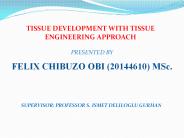Immunoisolation PowerPoint PPT Presentations
All Time
Recommended
Sequestration of cells within a semi-permeable membrane ... Allogeneic or xenogeneic? Primary post-mitotic cells? Mitotically active cells? ...
| PowerPoint PPT presentation | free to view
Tissue engineering is the combination of biology medicine and engineering to create products that would improve or replace biological functions. The medical biotechnology industry was estimated to be $160 billion in 2012.The major drivers in this industry are chronic wound and orthopedic application segment.
| PowerPoint PPT presentation | free to download
The global nanoporous membranes market size reached US$ 816.6 Million in 2022. Looking forward, IMARC Group expects the market to reach US$ 1,218.7 Million by 2028, exhibiting a growth rate (CAGR) of 6.7% during 2023-2028. More Info:- https://www.imarcgroup.com/nanoporous-membranes-market
| PowerPoint PPT presentation | free to download
Felsenstein Medical Research Center, Faculty of Medicine, Tel Aviv ... The green color of sea anemone, hydra and coral is due to symbiotic algae living ...
| PowerPoint PPT presentation | free to view
The inflating need for treating wastewater containing minute contaminants, on account of the increasing shortage of freshwater sources, is primarily driving the nanoporous membranes market Ask Analyst for Customization and Explore Full Report with TOC & List of Figure: Visit the following link: https://www.imarcgroup.com/nanoporous-membranes-market E-mail: sales@imarcgroup.com Contact: +91-120-415-5099
| PowerPoint PPT presentation | free to download
Biomaterials By Dr. Tejal Ashwin Desai, U. Illinois Chicago Modified, P. H. King, Vanderbilt U.
| PowerPoint PPT presentation | free to view
... in other cases the separation is not molecular but cellular. Filtration Hollow Fiber Membranes (HFM); Selective Separation; Materials Thermoplastics-PS, ...
| PowerPoint PPT presentation | free to download
... Probe Microscopy. Atomic Force Microscopy :Surface irregularities. Scanning Tunneling Microscopy: Conducting Surfaces. Adhesion Force Microscopy: Functionalised ...
| PowerPoint PPT presentation | free to view
Tissue Engineering is the development and practice of combining scaffolds, cells, and suitable biochemical factors (regulatory factors or Signals) into functional tissues. The goal of tissue engineering is to assemble functional constructs that restore, maintain, or improve damaged tissues or whole organs. Cells are the building blocks of tissue, and tissues are the basic unit of function in the body. Generally, groups of cells make and secrete their own support structures, called extracellular matrix. This matrix, or scaffold, does more than just support the cells; it also acts as a relay station for various signaling molecules. Thus, cells receive messages from many sources that become available from the local environment. Each signal can start a chain of responses that determine what happens to the cell.
| PowerPoint PPT presentation | free to download
TISSUE ENGINEERING Soft Tissue Biomaterials Alyssa Panitch Harrington Department of Bioengineering Arizona State University Soft Tissue Engineering Biology and ...
| PowerPoint PPT presentation | free to view
Orthopedic screws/fixation. Dental Implants. Dental Implants. Heart valves. Bone replacements ... Howmedica develops and manufactures products in orthopaedics. ...
| PowerPoint PPT presentation | free to view
Biomaterial A biomaterial is a nonviable material used in a medical device ... Alumina Orthopedic and dental devices. Hydroxyapatite Orthopedic and dental devices ...
| PowerPoint PPT presentation | free to view
'IMMUNOISOLATED CELLS IMPLANTS: FROM XENOTRASPLANTATION TO LOCOREGIONAL CHEMO ... Micrograph cross sectional view. G. Rasi. INMM-CNR. Top surface. Internal compartment ...
| PowerPoint PPT presentation | free to view
Marrow stem cells could heal broken bones, Betterhumans ... Horseshoe Crab endotoxins. Pig implant. Bacteria - genotoxicity ...
| PowerPoint PPT presentation | free to view
U'S' ARMY MEDICAL RESEARCH
| PowerPoint PPT presentation | free to view
Chem. , 2000, 275: 26128-26135. Gomes, I., Jordan, B.A., Gupta, A., Trapaidze, N., Nagy, V., Devi, L.A. Heterodimerization of mu and delta opioid receptors: ...
| PowerPoint PPT presentation | free to download
Using Tissue Engineering to Produce an Unlimited Supply of Tissues and Organs
| PowerPoint PPT presentation | free to view
U'S' ARMY MEDICAL RESEARCH
| PowerPoint PPT presentation | free to view


















